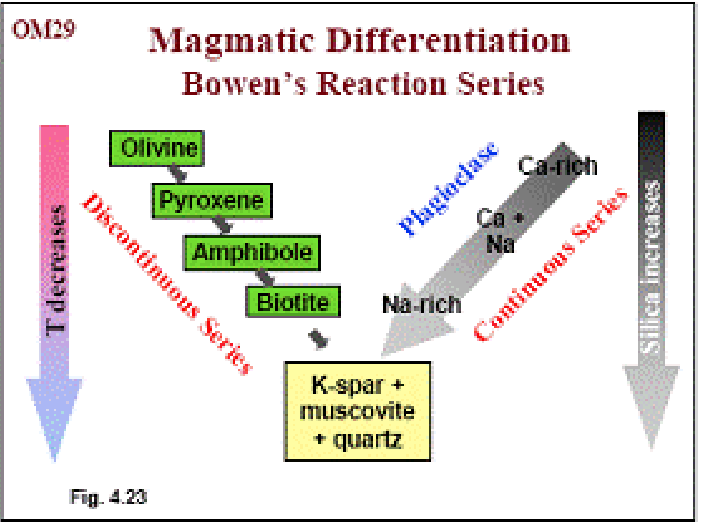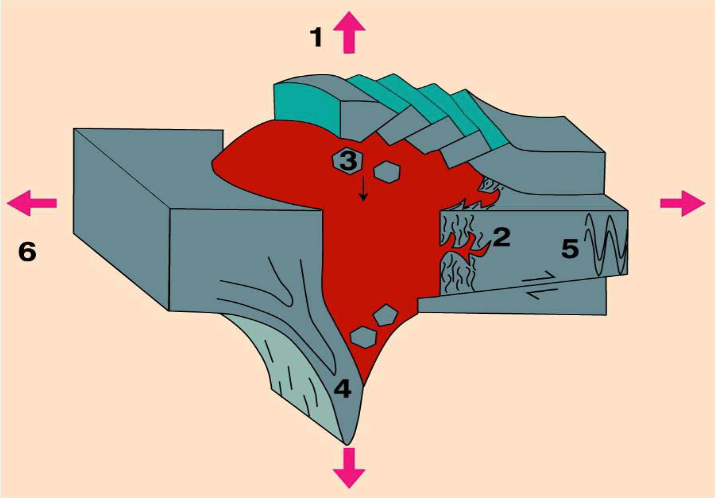9/10) Bowen and Differentiation & plutonic and volcanic processes
1/13
There's no tags or description
Looks like no tags are added yet.
Name | Mastery | Learn | Test | Matching | Spaced |
|---|
No study sessions yet.
14 Terms
what is a paragenetic sequence
describes the order in which mineral crystallization occurred in an igenous rock
minerals have different temps of crystallization, so they do not crystallize at the same time
it explains the textural variability of igneous rocks

details on bowen’s reaction series
temp decreases as you go down, silica increases as you go down
discontinuous series is olivine → pyroxene → amphibole → biotite
continuous series is plagioclase from Ca-rich to Na-rich
first minerals that crystallize from a cooling basaltic magma are olivine and Ca-rich plag
olivine then reacts with remaining molten magma to form pyroxene. the early formed plag reacts by changing composition towards Na-rich plag
pyroxene reacts to form amphibole, then biotite while plag continues to react and change towards Na-rich form
near end of cooling, alkali feldspar, quartz, and muscovite crystalize
not all rocks go through whole series; mafic rock won’t form a rock with k-spar, muscovite, or quartz
why is bowen’s series important. in regards to stability
quartz is a stable mineral on earth’s surface, so lots of sand is quartz
ultramafic are quickest to weather due to less stable
list different ways magmas change their composition
fractional crystallization, magma mixing, crustal assimilation, partial melting
explain fractional crystallization
crystals no longer react with liquid after they are behind another layer of crystals
most often in mafic rocks, low viscosity, crystals can actually settle and move
granitic magmas are highly viscous and thick, crystals would have a hard time moving down/up
explain the two ways of fractional crystallization
crystal settling/floating: crystals may move up or down depending on density (feldspars), olivine crystallizes first, olivine takes in Ni, so remaining magma is poor in Ni
inward crystallization: magma is hot and the country rock that surrounds it is much cooler. heat moves outwards away from the magma, the walls of the magma body are coolest, crystallization happens there first. Can form concentric zoning within the pluton, the center will be more felsic.
what is cumulate textures
looks like sedimentary rock
formed by accumulation of crystals from a magma either by settling or floating
skaergaard intrusion, in-situ differentiation, just sitting there having fractional crystalllization happen without addition of more crystals
explain magma mixing, what are factors that inhibit mixing
two or more magmas with different chem comps come in contact with another beneath the surface, mostly mingling, full mixing hard due to temp and comp diffs
inhibits
temp: basaltic and rhyolitic magmas have very diff temps, if they come in contact, basalt will cool or even crystallize, and rhyolite would heat up and dissolve
density: basalt is more dense, will sink below rhyolite
viscosity: vigorous stirring would be required to get them to mix (like oil and water, rhyolite is more viscous (more silica)
explain partial melting
separation of a partially melted liquid from the solid residue
requires a critical melt%
sufficient melt must be produced for it to form a continuous interconnected film
have enough interior volume that not all of it is adsorbed to the crystal surfaces
details on mantle composition
limited direct samples
ophiolites: slabs of oceanic crust and upper mantle
“obducted” = got stuck on continent
details on mantle melting
increased temp: geotherm = how temp changes with depth, get to solid+ liquid zone, can move the geotherm to the right to increase temp
lower pressure: adiabat = changing pressure under equal temp, decompression melting, like mid-ocean ridge melting, plates spreading apart causing less pressure
add volatiles: phlogopite, amphibole, serpentine are minerals that can contain water and affect soliduses by dehydrating, releating water and rpomoting melting because of the difference in saturated vs dry soliduses

how does magma intrude the crust
1: doming of roof, pushing up
2: wall rock assimilation, partial melting, zone melting
3: stoping, chunks of ceiling break off and fall into the magma
4: ductile wall rock deformation and wall rock return flow, magma going up, something goes down to replace it
5: lateral wall rock displacement by faulting or folding
6: emplacement into extension environment, rift zone, divergent tectonic environment
don’t happen in isolation, 2 probably happens a lot
details on effusive volcanoes
non-explosive
Aa lava = blocky, rough surface blocks, fragments, bulldozes over surface
Pahoehoe = ropy, smooth continuous skin, inflate from below, new lava comes in and raises the surface (only use these words for basalt)
low silica, mafic, high temp (1100°C), low viscosity, low gas content
details on explosive eruptions
when magma rises, P decreases, magma becomes saturated in water and begins to exsolve water as a separate fluid phase (gas bubbles form), more gas content and thicker magma means explosive eruptions likely
magma moving upwards can trigger seismic movement, and also the exsolution, which causes explosive eruptions, gad bubble fragments disrupt quickly
fragmentation zone: largely a response to pressure change as the magma ascends
high silica, felsic, low temp (800°C), high viscosity, high gas content